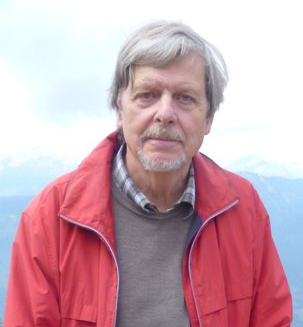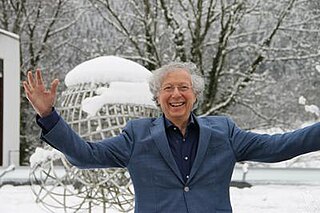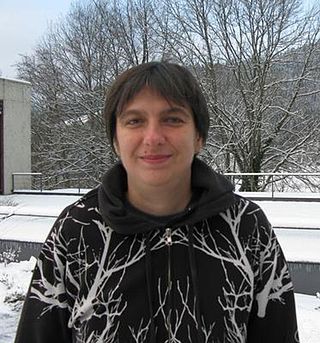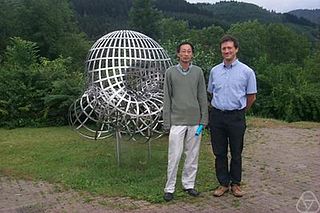
Edward Witten is an American theoretical physicist known for his contributions to string theory, topological quantum field theory, and various areas of mathematics. He is a professor emeritus in the school of natural sciences at the Institute for Advanced Study in Princeton. Witten is a researcher in string theory, quantum gravity, supersymmetric quantum field theories, and other areas of mathematical physics. Witten's work has also significantly impacted pure mathematics. In 1990, he became the first physicist to be awarded a Fields Medal by the International Mathematical Union, for his mathematical insights in physics, such as his 1981 proof of the positive energy theorem in general relativity, and his interpretation of the Jones invariants of knots as Feynman integrals. He is considered the practical founder of M-theory.
Algebraic quantum field theory (AQFT) is an application to local quantum physics of C*-algebra theory. Also referred to as the Haag–Kastler axiomatic framework for quantum field theory, because it was introduced by Rudolf Haag and Daniel Kastler. The axioms are stated in terms of an algebra given for every open set in Minkowski space, and mappings between those.
In mathematics and theoretical physics, braid statistics is a generalization of the spin statistics of bosons and fermions based on the concept of braid group. While for fermions (Bosons) the corresponding statistics is associated to a phase gain of under the exchange of identical particles, a particle with braid statistics leads to a rational fraction of under such exchange or even a non-trivial unitary transformation in the Hilbert space. A similar notion exists using a loop braid group.
In mathematical physics, noncommutative quantum field theory is an application of noncommutative mathematics to the spacetime of quantum field theory that is an outgrowth of noncommutative geometry and index theory in which the coordinate functions are noncommutative. One commonly studied version of such theories has the "canonical" commutation relation:

In theoretical physics, quantum field theory in curved spacetime (QFTCS) is an extension of quantum field theory from Minkowski spacetime to a general curved spacetime. This theory uses a semi-classical approach; it treats spacetime as a fixed, classical background, while giving a quantum-mechanical description of the matter and energy propagating through that spacetime. A general prediction of this theory is that particles can be created by time-dependent gravitational fields (multigraviton pair production), or by time-independent gravitational fields that contain horizons. The most famous example of the latter is the phenomenon of Hawking radiation emitted by black holes.

Rudolf Haag was a German theoretical physicist, who mainly dealt with fundamental questions of quantum field theory. He was one of the founders of the modern formulation of quantum field theory and he identified the formal structure in terms of the principle of locality and local observables. He also made important advances in the foundations of quantum statistical mechanics.

Karl-Henning Rehren is a German physicist who focuses on algebraic quantum field theory.

Detlev Buchholz is a German theoretical physicist. He investigates quantum field theory, especially in the axiomatic framework of algebraic quantum field theory.

Arthur Michael Jaffe is an American mathematical physicist at Harvard University, where in 1985 he succeeded George Mackey as the Landon T. Clay Professor of Mathematics and Theoretical Science.
In mathematical physics, Gleason's theorem shows that the rule one uses to calculate probabilities in quantum physics, the Born rule, can be derived from the usual mathematical representation of measurements in quantum physics together with the assumption of non-contextuality. Andrew M. Gleason first proved the theorem in 1957, answering a question posed by George W. Mackey, an accomplishment that was historically significant for the role it played in showing that wide classes of hidden-variable theories are inconsistent with quantum physics. Multiple variations have been proven in the years since. Gleason's theorem is of particular importance for the field of quantum logic and its attempt to find a minimal set of mathematical axioms for quantum theory.
In theoretical particle physics, the non-commutative Standard Model, is a model based on noncommutative geometry that unifies a modified form of general relativity with the Standard Model.
In mathematical physics, the concept of quantum spacetime is a generalization of the usual concept of spacetime in which some variables that ordinarily commute are assumed not to commute and form a different Lie algebra. The choice of that algebra varies from one theory to another. As a result of this change, some variables that are usually continuous may become discrete. Often only such discrete variables are called "quantized"; usage varies.

Huzihiro Araki was a Japanese mathematical physicist and mathematician who worked on the foundations of quantum field theory, on quantum statistical mechanics, and on the theory of operator algebras.
Categorical quantum mechanics is the study of quantum foundations and quantum information using paradigms from mathematics and computer science, notably monoidal category theory. The primitive objects of study are physical processes, and the different ways that these can be composed. It was pioneered in 2004 by Samson Abramsky and Bob Coecke. Categorical quantum mechanics is entry 18M40 in MSC2020.

Matilde Marcolli is an Italian and American mathematical physicist. She has conducted research work in areas of mathematics and theoretical physics; obtained the Heinz Maier-Leibnitz-Preis of the Deutsche Forschungsgemeinschaft, and the Sofia Kovalevskaya Award of the Alexander von Humboldt Foundation. Marcolli has authored and edited numerous books in the field. She is currently the Robert F. Christy Professor of Mathematics and Computing and Mathematical Sciences at the California Institute of Technology.

Roberto Longo is an Italian mathematician, specializing in operator algebras and quantum field theory.
In mathematical physics, two-dimensional Yang–Mills theory is the special case of Yang–Mills theory in which the dimension of spacetime is taken to be two. This special case allows for a rigorously defined Yang–Mills measure, meaning that the (Euclidean) path integral can be interpreted as a measure on the set of connections modulo gauge transformations. This situation contrasts with the four-dimensional case, where a rigorous construction of the theory as a measure is currently unknown.

Klaus Fredenhagen is a German theoretical physicist who works on the mathematical foundations of quantum field theory.

Alberto Sergio Cattaneo is an Italian mathematician and mathematical physicist, specializing in geometry related to quantum field theory and string theory.
Robert Schrader was a German theoretical and mathematical physicist. He is known for the Osterwalder–Schrader axioms.










